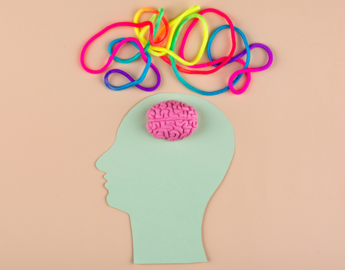UDL and mental well-being
Mental health and well-being are essential for both students and instructors in the classroom. Students who are stressed and overwhelmed may have lower grades, experience difficulty concentrating and lack engagement in a course (Pascoe et al., 2019). Instructors who are stressed and burned out may be less effective in the classroom. In this lesson, we examine how UDL can support positive mental health and foster flourishing in the classroom.
Lesson checklist
- Gain strategies to promote student well-being in a course
- Consider ideas to enhance educator well-being in the course
Positive learning environments
Creating a positive learning environment in both in-person and web-based courses contributes to both student and instructor well-being. Universal Design for Learning principles and practices can play a role in establishing that positive learning environment.
- Accessible courses allow students to engage in the learning environment, rather than placing barriers in their way.
- Create accessible course content.
- Aim for learning technologies that are easy to use on a variety of devices and freely available, such as campus-supported tools.
- Examine your teaching practices for ableism and disabling learning environments.
- Interaction and collaboration can be motivating for students, as well as benefitting their learning.
- Collaborative work can be in the form of graded assignments or in-class activities.
- Design courses for inclusivity.
- Create inclusive course outlines.
- Learn about anti-racism, EDI and positionality in teaching and learning.
- Use learning technologies to present content in different ways, such as a digital welcome note.
- Use a circle practice for the learning community to check in with one another.
- Encourage students to have an accountability partner to share responsibility within the learning community.
- Practise a pedagogy of kindness.
- Offering students a degree of choice in their studies allows them to personalize their learning and builds student autonomy.
- Some instructors incorporate flexibility around the type of assessments.
- Others might ask students to pick a topic for a paper from a list of approved options.
- Some tried and true in-class activities require no technology, only active engagement, such as a fishbowl, mind dump or think break.
- Web-based courses can also incorporate a wide variety of teaching and learning activities.
- Encourage participation in online synchronous classes via Zoom using activities such as think-pair-share.
- Collaborative activities could be graded or non-graded and are possible in both face-to-face and online courses.
- Give students time to pause and think during courses. Strategies such as recording lectures allow for flexibility, pausing and accessing lectures multiple times
- Think about crip time in your own work. Incorporate flexibility and challenge ideas of productivity during times of high activity or stress (Mason, 2023b).
Student assessment and well-being
Assessment can be a huge source of stress for students since there is so much at stake – continuing in a program, applying to other programs or graduate studies, and scholarships, to name a few. The following chart includes some strategies that could mitigate student stress and promote well-being. As an instructor, please carefully consider which ones would be appropriate for your course as some of them could place a burden on you in terms of grading or administration of the assessment, depending on class size and other factors.
Authentic assessment is a type of assessment in which students apply knowledge and skills in realistic tasks or settings. It will look different in different courses, based on the learning outcomes of the course. For example, if one of the learning outcomes focuses on report writing, an authentic assessment for the course would be to have students write a report.
By including different types of assessments, you allow students to demonstrate their learning in various ways. This can alleviate the pressure for students who have anxiety over certain types of assessments by ensuring the entire course grade is not dependent on being successful in a single assessment type. For example, this case study shows how an inquiry project was implemented in math.
Formative feedback helps students to gauge whether they are on track with their learning in a course, and where they may need to devote more time to their learning efforts. A variety of strategies can be used, including peer feedback, in-class activities and student response tools.
Strategies to mitigate student assessment anxiety include:
- Incorporate scaffolded assignments, where a project or paper is broken into steps with a grade and feedback at each step.
- Low-stakes assessments, such as short quizzes, given at the beginning of the term, so that students can get a sense for the expectations in the course.
- Provide cues for pacing in the course using a variety of tools, such as the LMS calendar, checklists and weekly emails with important dates and deadlines.
- Explore opportunities for students to practise tests and/or test questions to mitigate anxiety.
Demonstrate an ethics of care perspective by having class discussions about the assessments, and promoting assessment literacy – for example, by talking about strategies for writing a multiple-choice exam.
- Reimagine assessment for students: Ungrading, alternative forms of assessment.
- Reimagine assessment for instructors: Processes of merit, tenure and promotion, hierarchies in the academy (Mason, 2023a).
UDL and instructor well-being
It is critical for instructors to know that UDL does not need to be implemented all at once; rather, they can take small steps that enhance well-being. UDL can also be a shared responsibility in which students are collaborators in establishing and maintaining an accessible, engaging, positive learning environment.
The following strategies are designed with instructor well-being in mind.
- Setting clear expectations for student learning in the course should cut down on the number of emails and questions you get.
- Be transparent by having a well-articulated course outline that includes information about class activities, assignments and policies.
- Provide assignment guidelines with information about what learning is to be demonstrated, details around submission, deadlines, grading and other relevant details.
- Let students know how assignments will be graded by providing learning goals and rubrics in advance of submission.
Gathering mid-semester feedback from students allows instructors to gauge what is currently working in a course, and what might be improved. Small tweaks could result in more positive student evaluations at the end of the course.
Not all feedback needs to be provided by the instructor. Incorporate informal peer feedback processes during class time or incorporate peer feedback into assignments.
- By incorporating self-checks for understanding, students can monitor their own progress and learn to identify aspects of the course in which they need to improve.
- Embed student response questions into a lecture to check for understanding.
- Add non-credit quizzes in D2L for students to receive instant feedback on multiple-choice questions.
- Building student self-regulation and autonomy will likely take some time but pays off in the long run with learners who are increasingly capable of evaluating their own progress and identifying growth areas.
- Incorporate student goal setting early on in the course.
- Provide checklists for students to track their own progress
- Provide student choice where appropriate; for example, in weighting of assignments.
- Incorporate reflection and metacognitive activities into the course.
- Include a portfolio assignment in which students curate samples of their work and a reflection statement.
Activity
The attached chart can be used when planning a course. You will not be able to incorporate every UDL strategy at once, but will need to prioritize your ideas. Goal setting can help you to prioritize what you will do next, what you want to do in future, and things that are on your radar.
References
CAST. (2025). The UDL guidelines. https://udlguidelines.cast.org/
Mason, D. (Executive Producer & Host). (2023a, September 26). Episode 1: How might we reimagine assessment? With Jesse Stommel. In Three questions about teaching and learning. Taylor Institute for Teaching and Learning, University of Calgary. https://taylorinstitute.ucalgary.ca/resources/podcast/3qtl#jesse-stommel
Mason, D. (Executive Producer & Host). (2023b, November 8). Episode 3: Can we think differently about time? With Alan Santinele Martino. In Three questions about teaching and learning. Taylor Institute for Teaching and Learning, University of Calgary. https://taylorinstitute.ucalgary.ca/resources/podcast/3qtl#alan-martino
Pascoe, M. C., Hetrick, S. E., & Parker, A. G. (2020). The impact of stress on students in secondary school and higher education. International Journal of Adolescence and Youth, 25(1). https://doi.org/10.1080/02673843.2019.1596823







